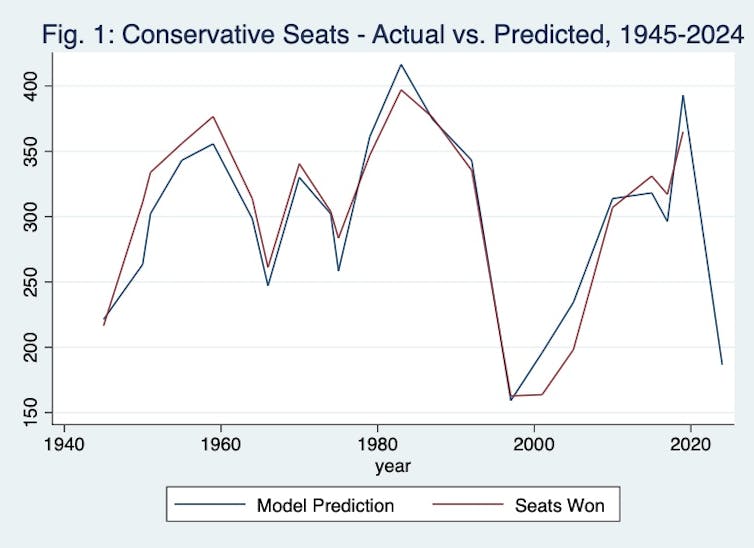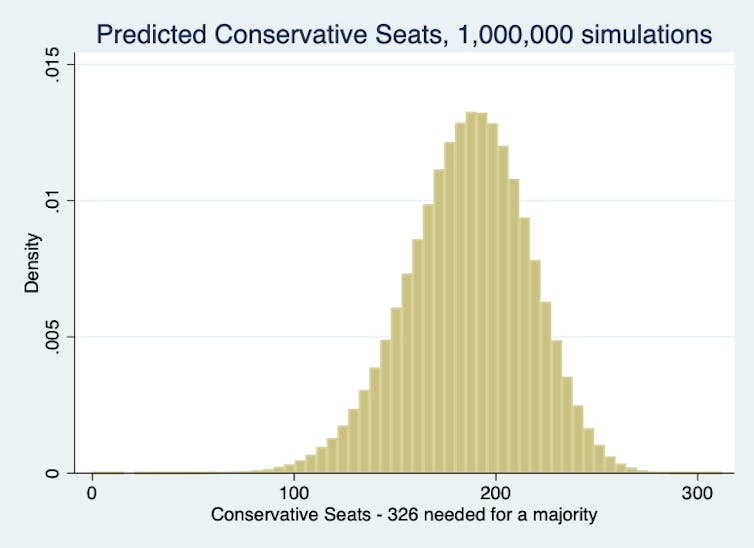British Prime Minister Rishi Sunak’s election call for July 4 was a surprise. Since the government could stay in power another six months and have an election in early 2025, why did Sunak opt to go early?
It’s unlikely the early call provides some unique opportunity to extend the Conservative Party’s rule yet again. Rather, a big loss is inevitable, and Sunak is perhaps being wise by getting this behind him and avoiding even worse outcomes such as losing the confidence of his party before an election. Avoiding a catastrophe might be the best Sunak can hope for.
Read more: Rishi Sunak and Keir Starmer's first election debate: the facts behind the claims
The concept of a political pendulum suggests that the public’s preferences swing back and forth between major parties in a predicable fashion. One party takes over, consolidates power, likely wins additional elections but inevitably loses favour with voters while the other party rises in the polls and ultimately takes power back.
This is a pattern seen in many democracies — after a while, the public is ready for a change. Usually, the timing of the swing is predictable. After 14 years in office, the pendulum is swinging hard away from the Conservative Party.
Accurately predicting UK elections
My American colleague Helmut Norpoth and I developed the PM and the Pendulum model, which has been successfully forecasting British elections since 2005.
For the 2005 election, the model forecasted a Labour lead of 132 seats over the Conservatives — close to the actual 159 Labour seat result.
For the 2010 election, the forecast was a hung parliament with the Conservatives ahead 311-265 — the actual result was 306-258. The model again correctly predicted Conservative wins in 2015, 2017 and 2019.
The model relies on two predictors — the cyclical patterns of previous election results for the major parties, and the level of approval for the prime minister. It’s not dependent on voter intention polls. This has both positive and negative implications.
On the negative side, as bad as the prime minister’s current approval rate is — about 17.5 per cent — the model is unlikely to predict a devastating Conservative loss. The history of recent British elections provides some boundaries for what the model will forecast since a loss as big as the current polls indicate is far outside the historical patterns.
On the positive side, forecasting the Conservatives to do much better than the polls are currently predicting — and perhaps being wrong by a wide margin — helps put into historical perspective just how bad the coming election seems likely to be for them.

Ultimate decline always on horizon
This is part of what election forecasting is about — not necessarily being prophetic, but estimating what history predicts for the outcome and then making comparisons to what actually happens.
The regular swing of the pendulum predicts that after two elections or so, the public begins to turn against the party in power. Being far ahead of the opposition in seats and in popularity can delay the transfer of power back. For example, the Tories under Margaret Thatcher built large enough majorities in 1983 and 1987 to allow them to hang on in a close contest in 1992.

Likewise, big wins for Labour in 1997 and 2001 made a 2005 win possible. Some unpopular opposition leaders helped keep those governments going as well, according to our research. But the inexorable decline of the governing party in terms of government approval, leader approval and voter intentions is always somewhere on the horizon.
The 2019 election was an interesting anomaly for British politics in that the Conservatives extended their parliamentary and electoral advantage after smaller wins in 2010, 2015 and 2017. The usual pattern would have seen a swing away from the Conservatives.
In fact, the PM and the Pendulum model predicted a 2.4-point Conservative lead and a 311-268 MP lead over Labour. Instead, the electoral effects of Brexit alongside Boris Johnson’s popularity and Jeremy Corbyn’s unpopularity gave the Conservatives a much bigger win: an 11.5 per cent lead over Labour, translating into a 365-203 majority government.
The momentum of such a resounding victory typically carries forward into the election that follows. But not this year.
A Labour landslide?
After 14 years of Conservative rule under five different prime ministers, the July 4 election will likely bring Labour back to power in a victory similar in size to New Labour and Tony Blair’s landslide in 1997.
This year’s inputs for the PM and the Pendulum model are the election results from 2019 and 2017, plus the adjusted level of prime ministerial approval. Sunak’s approval rating of 17.5 per cent is a dreadful sign for the Conservatives. Even when 35 per cent of voters say they will vote for parties other than Labour or the Tories, Sunak is nowhere close to pleasing half of the voters who are considering only the two major parties.
The model predicts a nine-point Labour lead over the Conservatives — well below the 22-point Labour lead the polls are currently showing. It is possible the eventual result will be more in line with this forecast than with current polls.
For one, the campaign could reignite some partisan identification among Conservative and Scottish Nationalist Party voters that would eat into the Labour lead. Or the polls could be overestimating the eventual support for the newly formed Reform Party, hiding a pocket of voters who will eventually return and vote Conservative.
But, most likely, Labour is heading to a victory that will be historic in size.
Next, applying our seats model, a nine-point Labour lead would translate into 381 seats for Labour and 186 for the Conservative Party — a very comfortable majority government for Labour, but short of the landslide scope suggested by the latest polling figures.
The figure below shows the history of forecasts against the actual election results (less the 2024 outcome). The predicted loss of 206 seats since 2019 would be even sharper than their 1997 drubbing (-171 seats from 1992):

Another way of predicting the election result is to conduct computer simulations that take into account uncertainty about the true value of PM Approval, and the predictive power of past elections:

Conservative prospects are dim
Even in a million simulated elections, the Conservatives don’t eke out any wins, let alone enough for a majority government.
Fourteen years and five prime ministers in, the political pendulum is swinging hard against the Conservatives. If the PM and the Pendulum forecast is close to correct, it will be as good as the outgoing government could hope for.
An incoming Labour government under Prime Minister Keir Starmer will have a large majority and a long time until public opinion begins to swing back to the Conservative Party again.

